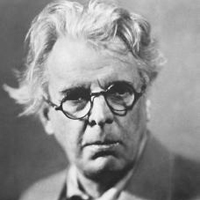Among School Children by William Butler Yeats: Critical Appreciation
Among School Children which was inspired by the poet’s visit to a convent school, possess the problem of aging and sets forth his philosophy of organic wholeness and unity of existence. When the poet as a senator visits the school, he looks at the children and meditates on aging.

William B. Yeats (1865-1939)
This mediation gradually develops into a philosophy which advocates the unity between past and the present, between man and his memories, between transcendental and physical, between passion and spirituality, and between body and soul for the fullness of existence or for the unity of existence.
The first stanza describes the convent school. It begins with the simplicity of school children. There is a nun and she is visited by the poet to know about the children. There are little girls who remind him of Maude Gonne. Problem of aging is put forward when he imagines of Maude Gonne to whom once he loved. He accepts the reality of aging. Fullness of existence (organic whole) is possible when there is a combination between childhood and aging.
The poet looking at a child starts meditating on his past in the second stanza. The child evokes in him the image of Maude Gonne as a child. He remembers that day when Maude Gonne complained him about certain things that caused some bitter feelings inside her. This stanza of the poem implies an association between man and his memory which later on becomes a part of Yeats’s philosophy of unity of existence. Moreover, the memory of childhood implies the unity between two different stages of life: childhood and old age. Yeats draws Plato’s parable which too is related to this philosophy of unity. Plato’s parable states that at the time of origin, human being was one. But fearful of the power of human being Zeus cut human into two halves. From then onwards, for the unity of existence, one half looks for the other.
The third stanza continues with the memories of Maude Gonne. Finding her image in a child standing before him the poet becomes passionate. The striking theme in this stanza is the confessional mode. It is shown by these lines, “and thereupon my heart is driven wild: She stands before me as a living child.” In which the poet to the surprise of the reader confesses the intensity of the passion inside his heart. As a public man he is supposed to behave on practical ground, but he cannot dominate his instinct and seems to be dominated by bodily desire.
The fourth stanza posits the problems of aging when the poet meditates on the present image of Maude Gonne as an old woman. The contrast between the past image of Maude Gonne and her present image brings the problem of aging the fore. The poet sees loss of physical beauty and turning of the beauty into some kind of shadowy mess. The poet with reference to painter and painting intensifies the theme of aging. The same problem of aging is repeated in the fifth stanza too, evoking motherhood, birth and old age. Yeats puts a question if the mother thinks that one day the child over which she pours much of her love and affection will turn into an old man like the poet himself.
Yeats brings the reference of transcendental philosophy of Plato, realistic manners of Aristotle, and the mythical existence of Pythagoras. In his analysis of philosophy of different levels he finds philosophy superficial because it fails to prevent the growing age. Mother’s solution centers on her expression of love and affection whereas nun’s includes worshipping idols of the immortals of gods, but both solutions are not in fact solutions. Neither passion (beloved) nor piety (nun) nor affection (mother) can prevent the growing age.
Very importantly the poet revolves around this own philosophy of existence in the last stanza. The poet now seems less concerned with how to prevent growing age than with how to achieve unity of existence. After observing insufficient labor of philosophy, mother, and nun he puts forward unity between body and soul as the best medium to realize the fullness. The age old poetic themes of innocence versus experience, naiveté versus wisdom, and youth versus age permeate every stanza. The poet proposes his own solution; one must accept reality for what it is, at once changing and changeless but always unified. The whole is more than the sum of its parts, just as the chestnut tree cannot be divided into leaf, blossom and bole separately, but all three put together in a larger whole. In the same manner, in the art of dancer as dancer cannot be separated from the dance, in human existence body and soul cannot be separated. The fullness of existence of chestnut tree is a joint effort of leaf, blossom and bole. The existence of art of dance depends on both dancer and the dance, the human existence requires unity between body and soul. Mind cannot be attributed the fixed location of the body. The imagination which operates in the poem is omnivorous because of its meditation on diverse events which are evoked from the poet’s past. The events in the poem such as reflection after reflection create an image of a kaleidoscope.
Cite this Page!
Sharma, K.N. "Among School Children by William Butler Yeats: Critical Appreciation." BachelorandMaster, 26 May 2017, bachelorandmaster.com/britishandamericanpoetry/among-school-children-critical-appreciation.html.
Related Topics
Among School Children: Introduction
Among School Children: Summary
The Scholars: Critical Analysis
Sailing to Byzantium: Analysis
The Theme of Immortality in Byzantium Poems
A Prayer for My Daughter: Analysis
Crazy Jane Talks with the Bishop
The Lamentation of the Old Pensioner
He Wishes for the Clothes of Heaven
An Irish Airman Foresees his Death
When You Are Old: Summary and Analysis
William Butler Yeats as a Symbolist
Truth of Human Life in Yeats's Poetry
Yeats and the Romantic Tradition
The Salient Features of Yeats's Poetry
Biography of William Butler Yeats
 |
bachelorandmaster.com |